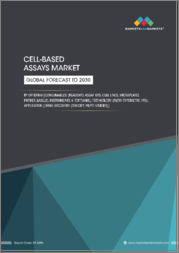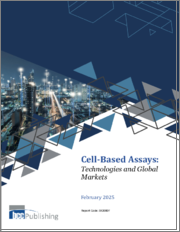
|
시장보고서
상품코드
1663138
세포 기반 어세이 시장 규모, 점유율, 성장 분석 : 제품별, 기술별, 용도별, 최종사용자별, 지역별 - 산업 예측(2025-2032년)Cell-Based Assays Market Size, Share, and Growth Analysis, By Offering (Consumables, Instruments), By Technology (Flow Cytometry, High-Throughput Screening), By Application, By End User, By Region - Industry Forecast 2025-2032 |
||||||
세포 기반 분석 세계 시장 규모는 2023년 172억 달러로 평가되었습니다. 2024년 184억 6,000만 달러에서 2032년에는 324억 3,000만 달러로 성장할 것으로 예상되며, 예측 기간(2025-2032년) 동안 7.3%의 연평균 복합 성장률(CAGR)을 보일 전망입니다.
코로나19 팬데믹은 전 세계 연구 상황에 큰 영향을 미쳤으며, 감염을 감지하기 위한 효율적인 방법의 신속한 채택과 연구 개발을 촉진했습니다. 주목할 만한 것은 T-Detect COVID-19 T세포 검사와 같은 검사가 FDA의 긴급사용승인을 받은 것은 진단학의 혁신을 보여주었습니다. 감염성 질환, 암, 자가면역질환, 유전자 이상 질환 증가로 인해 생명공학 연구의 필요성과 함께 신약개발에 대한 수요가 증가함에 따라 시장은 크게 성장할 것으로 예상됩니다. 세포 기반 약물 스크리닝 분석은 실행 가능한 약물 후보물질의 선택, 리드 화합물프로파일링, 세포 신호전달 분석, 독성 평가를 가능하게 하는 데 매우 중요합니다. Annexin V-Cy3 Apoptosis Detection Kit는 그 한 가지 예로서, 치료법 연구개발을 촉진하는 데 있어 이러한 분석의 다양성과 중요성을 강조합니다.
목차
서론
- 조사 목적
- 조사 범위
- 정의
조사 방법
- 정보 조달
- 2차와 1차 데이터 방법
- 시장 규모 예측
- 시장 전제조건과 제한
주요 요약
- 세계 시장 전망
- 공급과 수요 동향 분석
- 부문별 기회 분석
시장 역학과 전망
- 시장 개요
- 시장 규모
- 시장 역학
- 성장 촉진요인과 기회
- 성장 억제요인과 과제
- Porter의 Five Forces 분석
주요 시장 인사이트
- 중요 성공 요인
- 경쟁 정도
- 주요 투자 기회
- 시장 생태계
- 시장의 매력 지수(2024년)
- PESTEL 분석
- 거시경제 지표
- 밸류체인 분석
- 가격 분석
- 기술 분석
- 특허 분석
- 사례 연구
세포 기반 어세이 시장 규모 : 제공별&CAGR(2025-2032년)
- 시장 개요
- 소모품
- 시약
- 어세이 키트
- 리포터 유전자 어세이
- 세포 증식 어세이
- 2차 메신저 어세이
- 세포사 어세이
- 기타 어세이 키트
- 마이크로플레이트
- 세포주
- 불사화 세포주
- 1차 세포주
- 줄기세포주
- 프로브 및 라벨
- 기타 소모품
- 기기
- 서비스
- 소프트웨어
세포 기반 어세이 시장 규모 : 기술별&CAGR(2025-2032년)
- 시장 개요
- 유세포분석기
- HTS(High Throughput Screening)
- 무표지 검출
- 기타 기술
세포 기반 어세이 시장 규모 : 용도별&CAGR(2025-2032년)
- 시장 개요
- Drug Discovery
- 독성 연구
- 약물동태 연구
- 약력학 연구
- 기초 조사
- 유전학 연구
- 기타 용도
세포 기반 어세이 시장 규모 : 최종사용자별&CAGR(2025-2032년)
- 시장 개요
- 제약 기업 및 바이오테크놀러지 기업
- 계약연구기관
- 학술연구기관
세포 기반 어세이 시장 규모 : 지역별&CAGR(2025-2032년)
- 북미
- 미국
- 캐나다
- 유럽
- 독일
- 스페인
- 프랑스
- 영국
- 이탈리아
- 기타 유럽
- 아시아태평양
- 중국
- 인도
- 일본
- 한국
- 기타 아시아태평양
- 라틴아메리카
- 브라질
- 기타 라틴아메리카
- 중동 및 아프리카
- GCC 국가
- 남아프리카공화국
- 기타 중동 및 아프리카
경쟁 정보
- 주요 5개사 비교
- 주요 기업의 시장 포지셔닝(2024년)
- 주요 시장 기업이 채택한 전략
- 최근 시장 동향
- 기업의 시장 점유율 분석(2024년)
- 주요 기업 개요
- 기업 상세
- 제품 포트폴리오 분석
- 기업 부문별 점유율 분석
- 전년대비 매출 비교(2022-2024년)
주요 기업 개요
- Thermo Fisher Scientific, Inc.(United States)
- Promega Corporation(United States)
- Merck KGaA(Germany)
- PerkinElmer, Inc.(United States)
- Danaher Corporation(United States)
- Cell Signaling Technology, Inc.(United States)
- Bio-Rad Laboratories, Inc.(United States)
- Agilent Technologies, Inc.(United States)
- GE Healthcare(United Kingdom)
- Lonza Group Ltd.(Switzerland)
결론과 제안
LSH 25.03.31Global Cell-Based Assays Market size was valued at USD 17.2 billion in 2023 and is poised to grow from USD 18.46 billion in 2024 to USD 32.43 billion by 2032, growing at a CAGR of 7.3% during the forecast period (2025-2032).
The COVID-19 pandemic significantly impacted the global research landscape, prompting rapid adoption of efficient methodologies and the development of cell-based assays to detect infections. Notably, tests like the T-Detect COVID-19 T-cell test gained FDA Emergency Use Authorization, illustrating the innovation in diagnostics. As drug discovery demands rise alongside the need for biotechnology research due to increasing rates of infectious diseases, cancer, autoimmune disorders, and genetic anomalies, the market is positioned for substantial growth. Cell-based drug screening assays are crucial for selecting viable drug candidates, enabling lead profiling, cellular signaling analysis, and toxicity assessments. An example is the Annexin V-Cy3 apoptosis detection kit, highlighting the versatility and importance of these assays in advancing therapeutic research and development.
Top-down and bottom-up approaches were used to estimate and validate the size of the Global Cell-Based Assays market and to estimate the size of various other dependent submarkets. The research methodology used to estimate the market size includes the following details: The key players in the market were identified through secondary research, and their market shares in the respective regions were determined through primary and secondary research. This entire procedure includes the study of the annual and financial reports of the top market players and extensive interviews for key insights from industry leaders such as CEOs, VPs, directors, and marketing executives. All percentage shares split, and breakdowns were determined using secondary sources and verified through Primary sources. All possible parameters that affect the markets covered in this research study have been accounted for, viewed in extensive detail, verified through primary research, and analyzed to get the final quantitative and qualitative data.
Global Cell-Based Assays Market Segments Analysis
Global Cell-Based Assays Market is segmented by Offering, Technology, Application, End User and region. Based on Offering, the market is segmented into Consumables, Instruments, Services and Software. Based on Technology, the market is segmented into Flow Cytometry, High-Throughput Screening, Label-Free Detection and Other Technologies. Based on Application, the market is segmented into Drug Discovery, Basic Research, Genetic Studies and Other Applications. Based on End User, the market is segmented into Pharmaceutical & Biotechnology Companies, Contract Research Organizations and Academic & Research Institutes. Based on region, the market is segmented into North America, Europe, Asia Pacific, Latin America and Middle East & Africa.
Driver of the Global Cell-Based Assays Market
The rising incidence of chronic illnesses, including cancer, cardiovascular conditions, and neurodegenerative diseases, significantly drives the demand for sophisticated cell-based assays utilized in disease modeling and pharmaceutical testing. As healthcare professionals and researchers seek to innovate treatments and understand the complexities of these ailments, advanced assays become essential tools in their arsenal. These methodologies not only enhance the efficiency of drug development processes but also pave the way for more precise modeling of disease mechanisms. Consequently, this growing need for effective assessment techniques in the medical field is a major driver in the global cell-based assays market.
Restraints in the Global Cell-Based Assays Market
The Global Cell-Based Assays market faces significant restraints due to the resource-intensive nature of developing and conducting these assays. The associated costs for reagents, specialized equipment, and the need for skilled personnel can create substantial barriers, especially for smaller research organizations lacking the necessary financial and technical resources. This situation can hinder their ability to compete effectively in the market, limiting innovation and development opportunities. As a result, these factors may restrict the growth and accessibility of cell-based assays, potentially impacting the overall market dynamics and slowing advancements in related research fields.
Market Trends of the Global Cell-Based Assays Market
The Global Cell-Based Assays market is experiencing a notable trend towards the adoption of 3D cell culture models, driven by their enhanced ability to mimic in vivo physiological conditions. This transition is fostering more accurate drug screening and toxicity assessment, thereby increasing the effectiveness of preclinical testing. As research continues to emphasize the importance of biologically relevant platforms, the demand for advanced 3D cell culture technologies is likely to surge. This market shift reflects a broader commitment to improving drug development processes and ensuring better therapeutic outcomes, positioning 3D cell culture as a pivotal innovation in cell-based assay methodologies.
Table of Contents
Introduction
- Objectives of the Study
- Scope of the Report
- Definitions
Research Methodology
- Information Procurement
- Secondary & Primary Data Methods
- Market Size Estimation
- Market Assumptions & Limitations
Executive Summary
- Global Market Outlook
- Supply & Demand Trend Analysis
- Segmental Opportunity Analysis
Market Dynamics & Outlook
- Market Overview
- Market Size
- Market Dynamics
- Drivers & Opportunities
- Restraints & Challenges
- Porters Analysis
- Competitive rivalry
- Threat of substitute
- Bargaining power of buyers
- Threat of new entrants
- Bargaining power of suppliers
Key Market Insights
- Key Success Factors
- Degree of Competition
- Top Investment Pockets
- Market Ecosystem
- Market Attractiveness Index, 2024
- PESTEL Analysis
- Macro-Economic Indicators
- Value Chain Analysis
- Pricing Analysis
- Technology Analysis
- Patent Analysis
- Case Studies
- Global Cell-Based Assays Market Size by Offering & CAGR (2025-2032)
- Market Overview
- Consumables
- Reagents
- Assay Kits
- Reporter gene assays
- Cell growth assays
- Secondary messenger assays
- Cell death assays
- Other assay kits
- Microplates
- Cell Lines
- Immortalized cell lines
- Primary cell lines
- Stem cell lines
- Probes & Labels
- Other Consumables
- Instruments
- Services
- Software
Global Cell-Based Assays Market Size by Technology & CAGR (2025-2032)
- Market Overview
- Flow Cytometry
- High-Throughput Screening
- Label-Free Detection
- Other Technologies
Global Cell-Based Assays Market Size by Application & CAGR (2025-2032)
- Market Overview
- Drug Discovery
- Toxicity Studies
- Pharmacokinetic Studies
- Pharmacodynamic Studies
- Basic Research
- Genetic Studies
- Other Applications
Global Cell-Based Assays Market Size by End User & CAGR (2025-2032)
- Market Overview
- Pharmaceutical & Biotechnology Companies
- Contract Research Organizations
- Academic & Research Institutes
Global Cell-Based Assays Market Size & CAGR (2025-2032)
- North America (Offering, Technology, Application, End User)
- US
- Canada
- Europe (Offering, Technology, Application, End User)
- Germany
- Spain
- France
- UK
- Italy
- Rest of Europe
- Asia Pacific (Offering, Technology, Application, End User)
- China
- India
- Japan
- South Korea
- Rest of Asia-Pacific
- Latin America (Offering, Technology, Application, End User)
- Brazil
- Rest of Latin America
- Middle East & Africa (Offering, Technology, Application, End User)
- GCC Countries
- South Africa
- Rest of Middle East & Africa
Competitive Intelligence
- Top 5 Player Comparison
- Market Positioning of Key Players, 2024
- Strategies Adopted by Key Market Players
- Recent Developments in the Market
- Company Market Share Analysis, 2024
- Company Profiles of All Key Players
- Company Details
- Product Portfolio Analysis
- Company's Segmental Share Analysis
- Revenue Y-O-Y Comparison (2022-2024)
Key Company Profiles
- Thermo Fisher Scientific, Inc. (United States)
- Company Overview
- Business Segment Overview
- Financial Updates
- Key Developments
- Promega Corporation (United States)
- Company Overview
- Business Segment Overview
- Financial Updates
- Key Developments
- Merck KGaA (Germany)
- Company Overview
- Business Segment Overview
- Financial Updates
- Key Developments
- PerkinElmer, Inc. (United States)
- Company Overview
- Business Segment Overview
- Financial Updates
- Key Developments
- Danaher Corporation (United States)
- Company Overview
- Business Segment Overview
- Financial Updates
- Key Developments
- Cell Signaling Technology, Inc. (United States)
- Company Overview
- Business Segment Overview
- Financial Updates
- Key Developments
- Bio-Rad Laboratories, Inc. (United States)
- Company Overview
- Business Segment Overview
- Financial Updates
- Key Developments
- Agilent Technologies, Inc. (United States)
- Company Overview
- Business Segment Overview
- Financial Updates
- Key Developments
- GE Healthcare (United Kingdom)
- Company Overview
- Business Segment Overview
- Financial Updates
- Key Developments
- Lonza Group Ltd. (Switzerland)
- Company Overview
- Business Segment Overview
- Financial Updates
- Key Developments



















